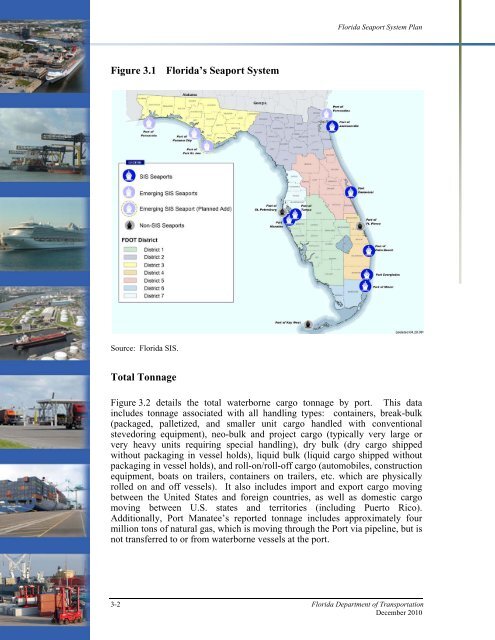Florida Seaport System Plan - SeaCIP
Florida Seaport System Plan - SeaCIP
Florida Seaport System Plan - SeaCIP
Create successful ePaper yourself
Turn your PDF publications into a flip-book with our unique Google optimized e-Paper software.
<strong>Florida</strong> <strong>Seaport</strong> <strong>System</strong> <strong>Plan</strong><br />
Figure 3.1 <strong>Florida</strong>’s <strong>Seaport</strong> <strong>System</strong><br />
Source: <strong>Florida</strong> SIS.<br />
Total Tonnage<br />
Figure 3.2 details the total waterborne cargo tonnage by port. This data<br />
includes tonnage associated with all handling types: containers, break-bulk<br />
(packaged, palletized, and smaller unit cargo handled with conventional<br />
stevedoring equipment), neo-bulk and project cargo (typically very large or<br />
very heavy units requiring special handling), dry bulk (dry cargo shipped<br />
without packaging in vessel holds), liquid bulk (liquid cargo shipped without<br />
packaging in vessel holds), and roll-on/roll-off cargo (automobiles, construction<br />
equipment, boats on trailers, containers on trailers, etc. which are physically<br />
rolled on and off vessels). It also includes import and export cargo moving<br />
between the United States and foreign countries, as well as domestic cargo<br />
moving between U.S. states and territories (including Puerto Rico).<br />
Additionally, Port Manatee’s reported tonnage includes approximately four<br />
million tons of natural gas, which is moving through the Port via pipeline, but is<br />
not transferred to or from waterborne vessels at the port.<br />
3-2 <strong>Florida</strong> Department of Transportation<br />
December 2010
















